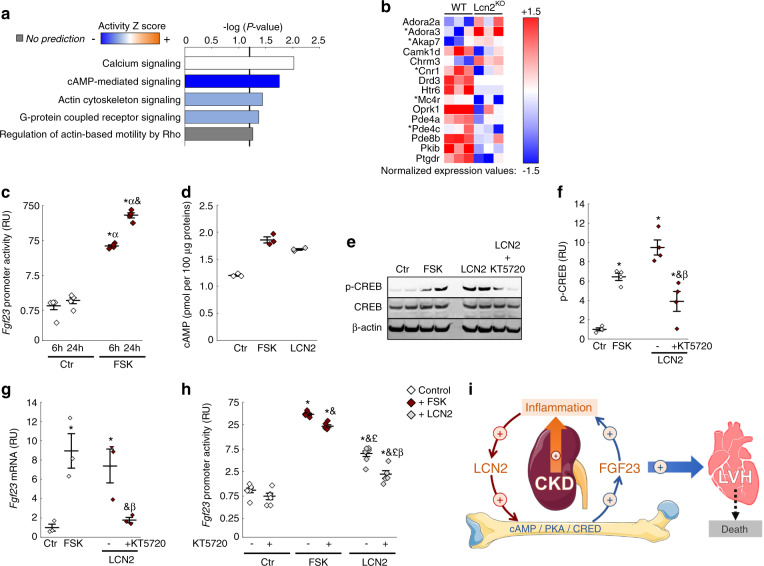Fig. 6.
cAMP signaling mediates lipocalin 2-induced bone stimulation of FGF23 production in osteoblasts. RNA sequencing of WT and Lcn2KO cortical bone identified 614 differentially regulated genes in Lcn2KO compared to WT (cutoffs: P < 0.05 and absolute fold change of 2). (a) Top 5 canonical pathways identified by ingenuity pathway analysis from the 614 genes dataset. (b) Normalized expression of dataset genes involved in the cAMP pathway with a twofold cutoff and P < 0.05 with the exception of *which indicates P < 0.1. (c) Fgf23 promoter activity in Control (Ctr) or Forskolin (FSK) -treated Fgf23 promoter-reporter MC3T3-E1 osteoblast cultures. (d) cAMP levels in Ctr, FSK, and LCN2 -treated MC3T3-E1 osteoblast cultures. (e) Representative micrograph and quantification (f) of western blotting detection of phosphorylated CREB (p-CREB) and total CREB, normalized to β-actin, in protein extracts from MC3T3-E1 osteoblasts treated with Ctr, FSK, and LCN2, and co-treated with LCN2 and cAMP inhibitor KT5720. Effects of Ctr, FSK, and LCN2 -treatment and KT5720 co-treatment on Fgf23 mRNA in MC3T3 osteoblasts (g) and promoter activity (h) in Fgf23 promoter-reporter MC3T3-E1 osteoblast cultures. Data are presented as mean ± SE, n ≥ 3 per group, P < 0.05 vs.* 6 h-Ctr, α 24 h-Ctr, and 6 h-FSK, £ 6 h-FSK + KT5720, β 6 h-LCN2. (i) Progressive alterations in kidney morphology and function induce inflammation-dependent lipocalin secretion leading to increased circulating LCN2. In bone, LCN2 increases FGF23 production through a cAMP/PKA/CREB-dependent mechanism, which contributes to excess FGF23 in CKD. Elevated FGF23 exerts pro-inflammatory effects, aggravating the inflammatory status in CKD. Excess FGF23 also targets the heart and contributes to the development of cardiac disease and mortality

